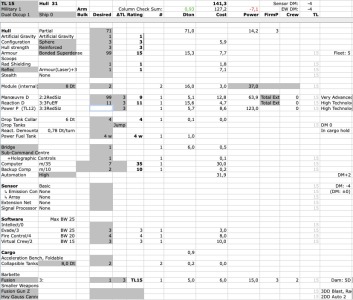AnotherDilbert
Emperor Mongoose
If we insist on having a pilot onboard we would have to limit the performance and build better people.
Take a fit, well-trained pilot (skill-2, characteristic 10 [DM +1]) and add:
Skill augment, Pilot skill+1, Cr 50 000
Skill augment, Gunner skill+1, Cr 50 000
Skill augment, Sensor skill+1, Cr 50 000
Genetic Environmental Adaption (Hi-G), Cr 50 000
Muscular Bridging, STR+1, DEX+1, Cr 250 000
Physical Augmentation, DEX+2, MCr 1
Physical Augmentation, END+2, MCr 1
Cockpit Sensory Suite, check+1, Cr 500 000
Neural Jack, expert +1, Cr 50 000
Put him into a Scout Battle Dress with three Enhanced Mobility for DEX+15 and a Sensor Suite for Elec(sensors)+3, Cr 610 000
Add High Automation (DM+2) and a sub-command centre (Pilot DM+1) to the fighter.
For a total of Pilot skill +5, Sensor skill +6, END+2 (DM+1), DEX+18 (DM+6).
On the G-LOC Pilot-END check we get a total DM of +10, and the genetic adaption removes ~1 G from the table.
The mutated monstrosity can survive uncompensated 11 G for some time...
Pretty expensive (MCr 3-4), but compared to a MCr 120 fighter it's peanuts.
Take a fit, well-trained pilot (skill-2, characteristic 10 [DM +1]) and add:
Skill augment, Pilot skill+1, Cr 50 000
Skill augment, Gunner skill+1, Cr 50 000
Skill augment, Sensor skill+1, Cr 50 000
Genetic Environmental Adaption (Hi-G), Cr 50 000
Muscular Bridging, STR+1, DEX+1, Cr 250 000
Physical Augmentation, DEX+2, MCr 1
Physical Augmentation, END+2, MCr 1
Cockpit Sensory Suite, check+1, Cr 500 000
Neural Jack, expert +1, Cr 50 000
Put him into a Scout Battle Dress with three Enhanced Mobility for DEX+15 and a Sensor Suite for Elec(sensors)+3, Cr 610 000
Add High Automation (DM+2) and a sub-command centre (Pilot DM+1) to the fighter.
For a total of Pilot skill +5, Sensor skill +6, END+2 (DM+1), DEX+18 (DM+6).
On the G-LOC Pilot-END check we get a total DM of +10, and the genetic adaption removes ~1 G from the table.
The mutated monstrosity can survive uncompensated 11 G for some time...
Pretty expensive (MCr 3-4), but compared to a MCr 120 fighter it's peanuts.



